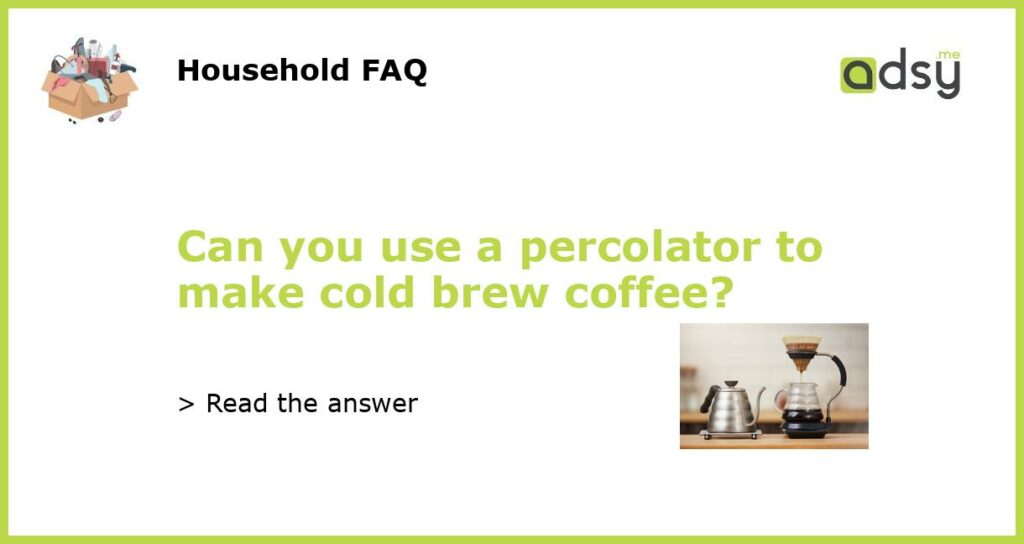Yes, you can use a percolator to make cold brew coffee
If you’re a coffee connoisseur, chances are you’ve heard of cold brew coffee. This trendy brewing method involves steeping coffee grounds in cold water for an extended period of time, resulting in a smooth and less acidic cup of joe. While the traditional way to make cold brew involves using a French press or a specialized cold brew system, some coffee enthusiasts have found success in using a percolator. In this article, we’ll explore how you can use a percolator to make cold brew coffee.
What is a percolator?
Before we dive into making cold brew with a percolator, let’s first understand what a percolator is. A percolator is a type of coffee brewing device that works by cycling boiling water through the coffee grounds repeatedly. This continuous boiling and cycling process gives percolated coffee a strong and robust flavor. Traditionally, percolators were a popular way to brew coffee, but they have since been replaced by other brewing methods such as drip coffee makers and espresso machines. However, some people still enjoy the unique taste that percolated coffee provides.
How to make cold brew coffee with a percolator
Now that we know what a percolator is, let’s explore how you can use it to make cold brew coffee. The process is relatively simple and requires just a few additional steps compared to making hot coffee with a percolator.
1. Select your coffee grounds: Just like with traditional cold brew methods, it’s important to choose the right coffee grounds. Opt for a coarse grind to prevent the coffee from becoming bitter during the extended brewing process.
2. Measure your coffee and water: For every 1 cup of water, use about 1 ounce (28 grams) of coffee grounds. Adjust the ratio to your desired strength.
3. Fill the percolator: Fill the percolator with cold water, making sure not to exceed the maximum fill line.
4. Add the coffee grounds: Place the coffee grounds in the percolator basket or chamber, depending on the design of your percolator.
5. Assemble the percolator: Fit the percolator lid securely and place it on the stove over low heat.
6. Monitor the process: Keep an eye on the percolator as the water begins to heat up. Allow it to percolate for around 15-20 minutes.
7. Remove from heat: Once the percolation process is complete, remove the percolator from the heat source and let it cool down to room temperature.
8. Strain and enjoy: Once the cold brew has cooled down, strain it using a fine-mesh sieve or a coffee filter. This will remove any coffee grounds and solids, leaving you with a smooth and refreshing cold brew coffee.
Considerations when using a percolator for cold brew coffee
While using a percolator to make cold brew coffee is possible, it’s important to note a few considerations before you start the process:
1. Flavor and acidity: Cold brew coffee is known for its low acidity and smooth flavor profile. Percolated coffee, on the other hand, tends to be stronger and more acidic. Keep this in mind when deciding whether to use a percolator for cold brew.
2. Brew time: Traditional cold brew methods involve steeping the coffee grounds in cold water for 12-24 hours. With a percolator, the brewing time is significantly shorter – usually around 15-20 minutes. This shorter brew time may result in a different flavor profile compared to traditional cold brew.
3. Experimentation: As with any brewing method, it may take some trial and error to find the right ratio of coffee grounds to water and the perfect brewing time to achieve the desired flavor in your cold brew.
4. Cleaning: Percolators can be more challenging to clean compared to other brewing methods. Make sure to thoroughly clean all parts of the percolator after each use to prevent any buildup of oils or residue.
In conclusion
While using a percolator to make cold brew coffee is not the traditional method, it is certainly possible and can result in a unique and flavorful cup of cold brew. Keep in mind the differences in flavor and brewing time compared to traditional cold brew methods, and don’t be afraid to experiment to find the perfect balance of coffee grounds, water, and brewing time that suits your taste preferences. So, if you’re curious to give it a try, dust off that old percolator and enjoy the process of making cold brew coffee with a twist!






